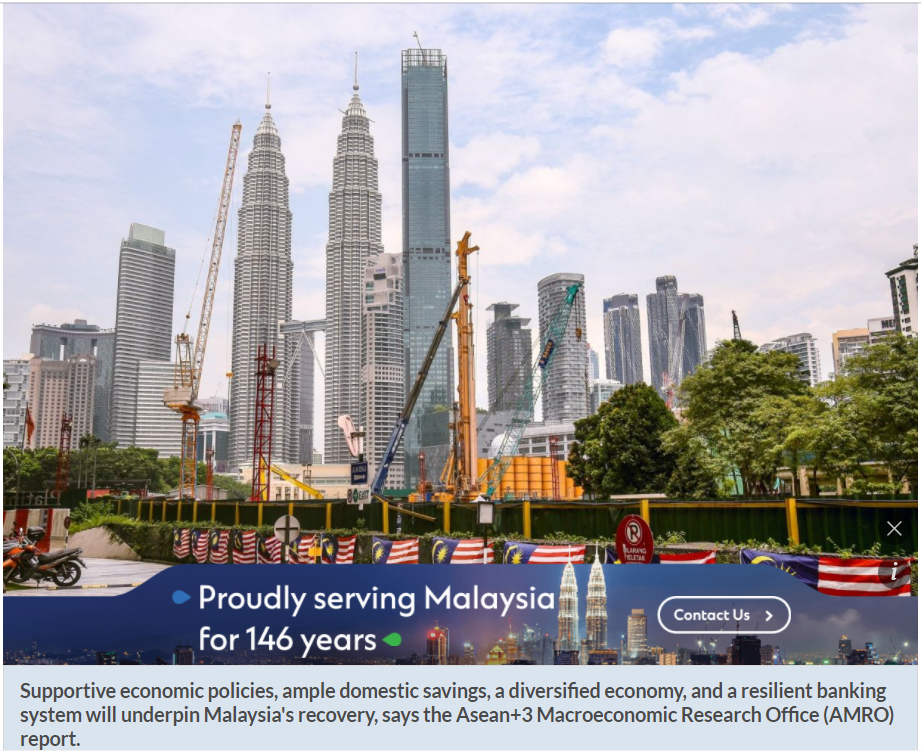Malaysia in strong position to ride recovery, report says
KUALA LUMPUR: Malaysia is in a strong position to ride a vaccine-led global economic recovery once the domestic Covid-19 situation is under control, according to the Asean+3 Macroeconomic Research Office (AMRO).
“Increasing coverage of ongoing vaccination programmes globally bodes well for a broader pick-up in global demand andMalaysia’s external sector, ” it said in its just published annual consultation report on Malaysia on Tuesday
The report pointed out a strong rebound in Malaysia’s domestic demand could likewise ensue, especially once the current wave of local infections is under control.
Against this backdrop, AMRO expects GDP growth to rise from -5.6% in 2020 to 5.6% in 2021 and 6.2% in 2022.
Underpinning the recovery will be supportive economic policies, ample domestic savings, a diversified economy, and resilient banking system, it said.
However, it also pointed out notwithstanding the strong rebound, the damage to the balance sheets of businesses and the labour market suggests the economy may not return to its pre-pandemic growth path in the short term.
The report also acknowledged Malaysia’s swift deployment of a comprehensive economic package has crucially supported the recovery.
The Covid-19 stimulus response, comprising both on-and off-budget spending, was successively expanded as the economic impact of the pandemic mounted.
By March 2021, it had grown to RM340bil or about 22% of GDP. Guided by fiscal prudence, on-budget spending — primarily through cash transfer and wage subsidy schemes — was about a fifth of the total package.
“The continuation of both on-and off-budget measures through 2021 is appropriate to ensure that the economic recovery remains on track, ” it said.
The report pointed out the weak inflationary environment provided Bank Negara Malaysia ample room to ease monetary policy to stabilise financial markets and support the economy during the Covid-19 crisis.
The overnight policy rate was lowered by a total of 125 basis points in the first seven months of 2020 to a record low of 1.75%, where it has remained since.
On the banking system, it is in a strong position to manage increased credit risks and facilitate continued credit expansion.
Banks’ liquidity coverage ratio stayed over 140% throughout 2020 even as the 100% minimum requirement was relaxed temporarily during the period.
“Meanwhile, stress-testing exercises by AMRO and Bank Negara indicate the banks have ample room to absorb loan impairments given their strong capital buffers, ” it said.
But it also cautioned Malaysia’s economic outlook remains subject to the uncertain developments of the pandemic.
A prolonged resurgence of Covid-19 infections and delays in the pace of vaccinations, in Malaysia and the major economies, cast a cloud over the growth outlook.
“In a tail risk scenario, a protracted decline in economic activity would imperil the soundness of the financial system, and lead to renewed market distress.
“Expanding the fiscal stimulus would be appropriate in this situation, although another adjustment to the debt limit could heighten concerns over debt sustainability.
“On the upside, a faster containment of the current wave of infections in and outside Malaysia could lead to an earlier and sharper economic rebound relative to our baseline scenario, ” it said.
The report also highlighted the need to restore fiscal buffers when the economic recovery is on a firm footing due to the build-up in government debt.
In AMRO’s view, reforms to broaden the tax base would be necessary to lower the fiscal deficit and guide the government debt back to the pre pandemic statutory limit of 55% of GDP over the medium term.
Revenue measures, including the re-instatement of the goods and services tax, should be planned and implemented in such a way to avoidacliff effectto growth.
The monetary policy should be on an easing bias as uncertainty continues to cloud the growth outlook.
It added despite the recent weakening in the recovery momentum, the current low policy rate remains accommodative and should be given more time to be transmitted fully to the real economy.
“But with risks to the outlook tilted to the downside and given available policy space, it would be appropriate to maintain an easing bias to ensure that monetary conditions remain supportive in the event of a sharper weakening in economic activity.
“That said, the low interest rate environment calls for vigilance against a potential build-up of financial imbalances, ” it said.
Source: https://www.thestar.com.my/business/business-news/2021/05/04/malaysia-in-strong-position-to-ride-recovery-report-says


 Thailand
Thailand




